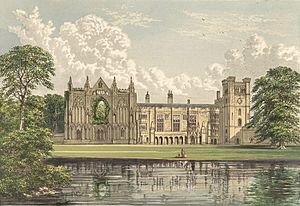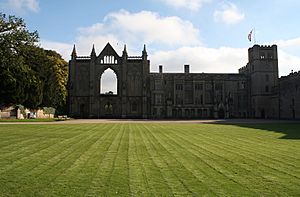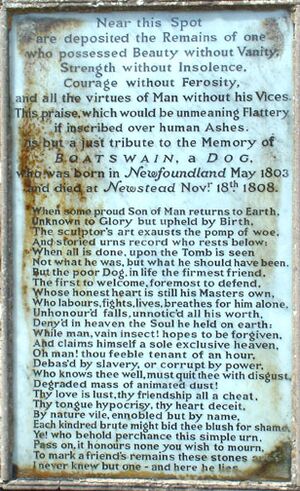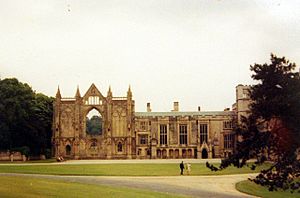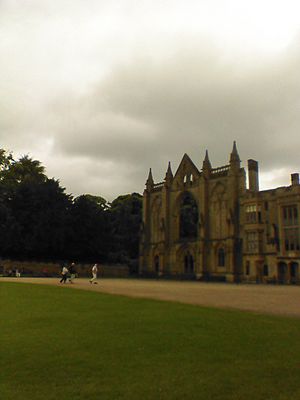Newstead Abbey facts for kids
Quick facts for kids Newstead Abbey |
|
|---|---|
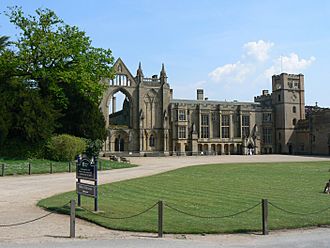 |
|
| General information | |
| Coordinates | 53°04′42″N 1°11′33″W / 53.078333°N 1.1925°W |
| Construction started | ca 1170 |
| Owner | Nottingham City Council |
| Designations | Grade I listed building |
Newstead Abbey is a historic estate in Nottinghamshire, England. It was once a priory, which is a type of monastery. After monasteries were closed down in England, it became a private home. Today, it is famous for being the family home of the famous poet, Lord Byron.
Contents
A Priory from Long Ago
Newstead Abbey was originally a priory called St. Mary of Newstead. It was founded around 1170 by King Henry II of England. He built it as a way to make up for the murder of Thomas Becket. Even though it's called an "Abbey" now, it was always a priory. This means it was a smaller religious house.
The priory was built bigger in the late 1200s and again in the 1400s. More parts were added, like the Dorter (where monks slept) and the Great Hall. It was designed for at least 13 monks. However, when the priory was closed, there were only 12 monks, including the leader, called the Prior.
In 1539, the priory was officially closed down. This was part of a big event called the Dissolution of the Monasteries. During this time, many religious buildings in England were shut by the King. The monks who lived there were given small pensions.
Later, in the late 1700s, something cool was found in the priory's fishpond. It was a lectern, which is a stand for holding books. The monks had thrown it into the pond to save it when the priory was closed! This lectern is now at Southwell Minster.
From Priory to Country Home
After the priory was closed, King Henry VIII gave Newstead Abbey to Sir John Byron in 1540. Sir John began turning the old religious building into a large family home. His family made many changes and additions over the years.
One of the later owners was William Byron, 5th Baron Byron. He spent a lot of money on the estate when he was young. He built fun, old-fashioned "follies" (decorative buildings) and even had pretend navy battles on the lake! But he also loved horse-racing, gambling, and theatre. He took out many loans and ended up in financial trouble.
To try and fix his money problems, he hoped his son would marry a rich heiress. But his son married his cousin instead, which ruined the plan. William, the 5th Lord Byron, had to sell many valuable things from the Abbey, like art, furniture, and even trees, to pay his debts. He couldn't bring the Abbey back to its grand past.
He lived a long life, outliving all his children and even his only grandson. When he died in 1798, his great-nephew, George Gordon Byron, became the next owner. George was only 10 years old at the time. He later became the very famous poet, Lord Byron.
Lord Byron's Connection
When young Lord Byron first saw Newstead Abbey, he was very impressed. The huge estate made him feel important. But the Abbey also had many problems. It was falling apart, and the family didn't have much money. Byron and his mother didn't live there all the time. He saw the Abbey as a romantic ruin, a symbol of his family's past glory. He wrote:
Thro' thy battlements, Newstead, the hollow winds whistle;
Thou, the hall of my fathers, art gone to decay.
In 1803, the estate was rented out for five years. When the lease ended in 1808, Byron returned. He started making many expensive changes to the Abbey. However, his changes were mostly for decoration, not for fixing the building's main problems. So, rain and damp soon damaged his new decorations.
Byron had a beloved Newfoundland dog named Boatswain. Sadly, Boatswain died in 1808. He was buried at Newstead Abbey, and his monument is even bigger than where Byron himself would eventually be buried! The words on Boatswain's monument are from Byron's famous poem, Epitaph to a Dog:
Near this Spot Are deposited the Remains of one Who possessed Beauty Without Vanity, Strength without Insolence, Courage without Ferosity, And all the Virtues of Man without his Vices. This Praise, which would be unmeaning flattery If inscribed over Human Ashes, Is but a just tribute to the Memory of "Boatswain," a Dog Who was born at Newfoundland, May, 1803, And died at Newstead Abbey Nov. 18, 1808.
Byron wanted to be buried with Boatswain. But he was later buried in his family's vault at the nearby Church of St Mary Magdalene, Hucknall.
Byron really wanted to keep Newstead. He said, "Newstead and I stand or fall together." He tried to get a loan using the property, but his advisor told him to sell it. Selling the Abbey became a big problem for many years.
He tried to sell it several times. In 1812, it went to auction but didn't sell for enough money. A buyer was found later, but the sale fell through. Byron was in debt and kept spending money, thinking the house would sell. Finally, in 1814, the sale was cancelled. Byron was left with money problems.
Later Owners and Today
Colonel Thomas Wildman's Restoration
In 1818, while Byron was living in Italy, a buyer was finally found for Newstead Abbey. Thomas Wildman, who had gone to school with Byron, bought it for a large sum of money. This helped Byron with his financial troubles.
Wildman spent a lot of money on the Abbey and its contents. He worked to restore it to its former glory. An architect named John Shaw Sr. designed new parts of the Abbey for Wildman.
William Frederick Webb and Public Ownership
In 1861, William Frederick Webb, an explorer, bought the Abbey. Famous people like David Livingstone visited the Abbey during Webb's time. Under Webb, the chapel was redecorated. After Webb died in 1899, the estate was passed down through his family.
Finally, in 1931, Webb's grandson sold Newstead to Sir Julien Cahn. Sir Julien then gave the Abbey to Nottingham Corporation (now Nottingham City Council).
Newstead Abbey Today
Today, Newstead Abbey is owned by Nottingham City Council. It is a museum that holds many items related to Lord Byron. The Abbey is also a popular place for weddings and other events. Visitors can explore its history, beautiful grounds, and learn about the famous poet who once called it home.


